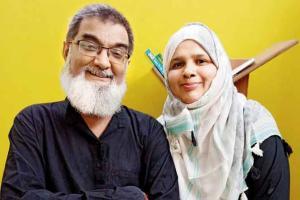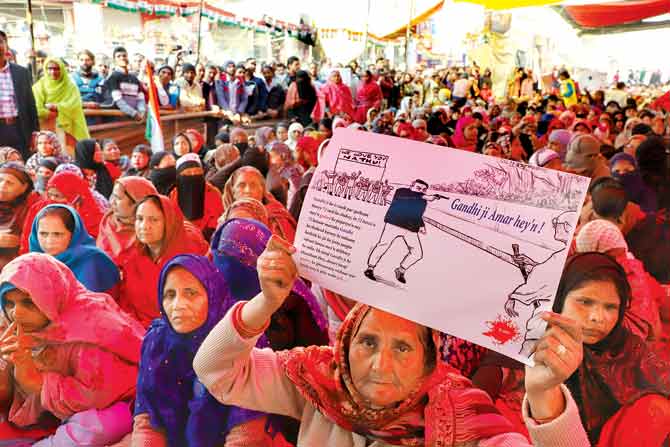A husband and wife who participated in a first-of-its-kind movement led by the Muslim women of Delhi, discuss how it became a metaphor for resistance

Ziya Us Salam and Uzma Ausaf
A FEW days into the stir at Delhi's Shaheen Bagh, which saw women from the Muslim community come out in droves to protest the controversial triad of National Population Register, National Register of Citizens and Citizenship Amendment Act, journalist-author Ziya Us Salam was invited to address them in the capacity of a journalist and an important voice of the community. This was in the last week of a freezing December, nearly seven days after the attack on students at Jamia Millia Islamia University, which had, in fact, bolstered these women to leave the confines of their homes to voice their protest. For some, it was perhaps, their first time in public eye. At the time, Salam had not thought much about the movement. "I went there with several preconceived notions. Like others, I didn't take them very seriously, and wondered if they'd know anything about nationalism or even the Constitution," he remembers. But a few hours at Shaheen Bagh were enough to alter those views. "It was a heart-warming experience. I came back chastened and enlightened." For the next few months, Salam and his wife Uzma Ausaf, a former journalist, would keep visiting Shaheen Bagh—a Muslim colony founded by one Ansarullah around 30 years ago, on tracts of agricultural land—to witness and live through this
new revolution.
Their new book, Shaheen Bagh: From a Protest to a Movement (Bloomsbury India) documents the journey of the making of Shaheen Bagh, and how within a matter of weeks, it spawned a hundred other mini movements across the country, including Mumbai. "As an Indian, as a Muslim and as a man, I was proud of what these women were doing," says Delhi-based Salam, who spent many mornings before work at the protest site. "For so long, the Indian media had portrayed Muslim women as helpless, vulnerable and fearful. This was far from the lived reality. So, when Shaheen Bagh happened, it surprised many people, including well-wishers who had imbibed that propaganda," he says, in a telephone interview. While the women countered this "propaganda" in the most efficient manner, what was most moving about the protest, says Salam, is that they didn't "come out to protest, as Muslims, but as Indian citizens". "They didn't bring a copy of the Quran or any fictitious green flag associated with the Muslims. They, instead, came with a tricolour flag in one hand, and the Constitution in the other. None of their demands were about the community. It was about the Right to Equality, given to them in Article 14 [of the Constitution]."
Not everybody, at Shaheen Bagh, was a homemaker as erroneously believed, the authors say. Some were teachers and lecturers, while others were lawyers, doctors and businesswomen. Many were grandmothers too. And, it was only women, who called all the shots here. "Take the seating arrangements, for instance. As one stands on the stage, one finds only rows and rows of women in front. Most sit cross-legged, one or two would have a chair or a stool they would have brought from home as physical limitations do not permit them to sit on the floor for long hours. Many are old, some have back or knee problems, some have had a child recently. The grandmothers are on a raised platform; they sit on a wooden takht (bed), just near the road divider… The men? They are all side-lined, literally and otherwise. They stand behind a rope which is tied from one end to the other in a rectangle, making sure no man enters the women's-only zone," the authors write in the book. They also mention that if the speakers "got monotonous and soporific" the women would wake them up in their own unique ways, bursting into the popular slogan Inquilaab Zindabad in the middle of a speech, in order to let the person on stage know in no uncertain terms that they have had enough of the lecture.

Women take part in a protest in February against the Citizenship Amendment Act (CAA) and NRC at Shaheen Bagh in New Delhi. Pic/ Getty Images
Salam decided to co-author the book with his wife Ausaf, because she had participated in the protest, spending several nights in the biting cold, sharing the same mattress with the protesters, sleeping and waking up for prayers with them. "They were very concerned about the India that their children and grandchildren were going to inherit. And, that's why they held their ground," shares Ausaf, who is also a children's writer. Contrary to a ruling party leader's accusation of the women sitting "in protest for a plate of biryani and R500," Ausaf says that many of them didn't even get dinner on most days. "They didn't know when or where their next meal would come from. In the evenings, some Good Samaritan would bring them tea and biscuits, and they would have that, and go to sleep." She recalls how a four-month-old child who was with his mother, unfortunately, could not bear the chill, and died. "His mother remained undaunted, and was back at the protest on the fourth day of his death," she shares in the book.
"And yet, their patriotism was questioned time and again," says Salam. There were many, who claimed that Shaheen Bagh was politically-motivated, and was not anti-CAA, but anti-government. But political leaders, especially the Congress, were stonewalled by the women, and not given an opportunity to speak even once, he adds.
While it was the women of Shaheen Bagh who were the "agents of change," the movement, in many ways, changed them too. "Muslim women had finally discovered their voice. They had stayed silent far too long, and their opinions were never considered, even during the Shah Bano Begum case or the criminalisation of Triple Talaq and Babri Masjid. It was always the maulanas who spoke up. This movement was important, because they finally asserted themselves and how," he says, adding that at no point, did the protests turn violent. "When a pro-CAA protest took place on the 50th day of their demonstration, very close to their site, these women were not intimidated by the men, even though they were shouting provocative slogans. They stood there with rose petals in thalis, to greet them," adds Salam. He still remembers the show of strength during the Republic Day celebrations on January 26. "Over 40,000 women and men had gathered there to hoist the tricolour flag. Many of them had travelled 20 to 30 km to be there. Shaheen Bagh had become a pilgrimage centre for secular India."
When PM Narendra Modi announced the Janata Curfew on March 22, before the lockdown, Salam says they abided by it, "but in a beautiful show of resistance, they all left their slippers at the protest site". "Only one of the seniormost dadis continued the protest that day. I don't think any man would have thought of something like this. It was done to remind everyone that they had only retreated, not surrendered."
Catch up on all the latest Mumbai news, crime news, current affairs, and a complete guide from food to things to do and events across Mumbai. Also download the new mid-day Android and iOS apps to get latest updates.
Mid-Day is now on Telegram. Click here to join our channel (@middayinfomedialtd) and stay updated with the latest news
 Subscribe today by clicking the link and stay updated with the latest news!" Click here!
Subscribe today by clicking the link and stay updated with the latest news!" Click here!









